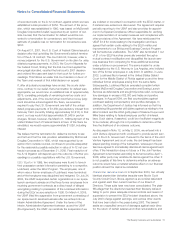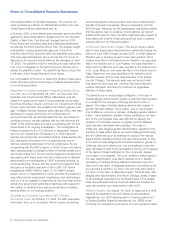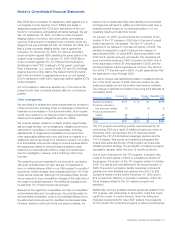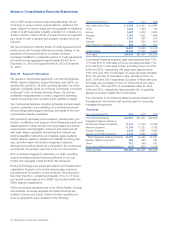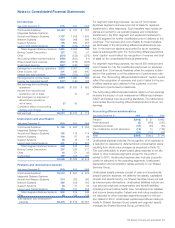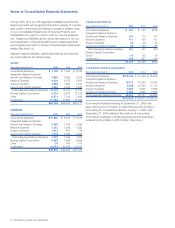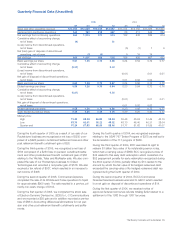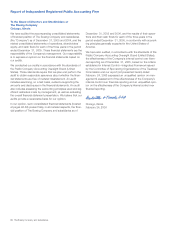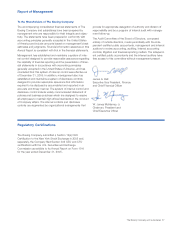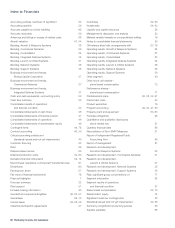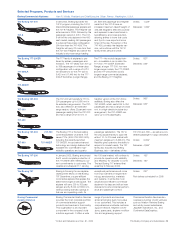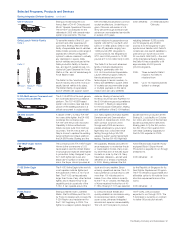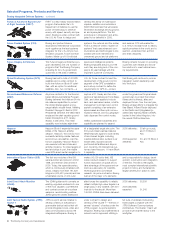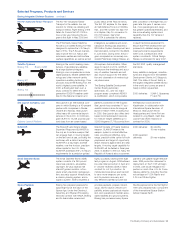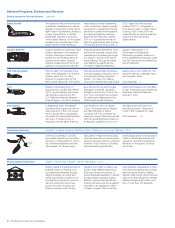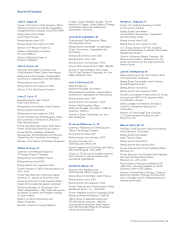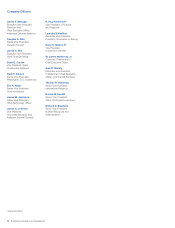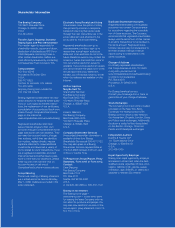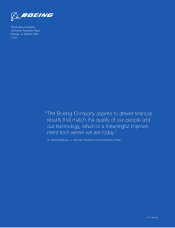Boeing 2005 Annual Report Download - page 91
Download and view the complete annual report
Please find page 91 of the 2005 Boeing annual report below. You can navigate through the pages in the report by either clicking on the pages listed below, or by using the keyword search tool below to find specific information within the annual report.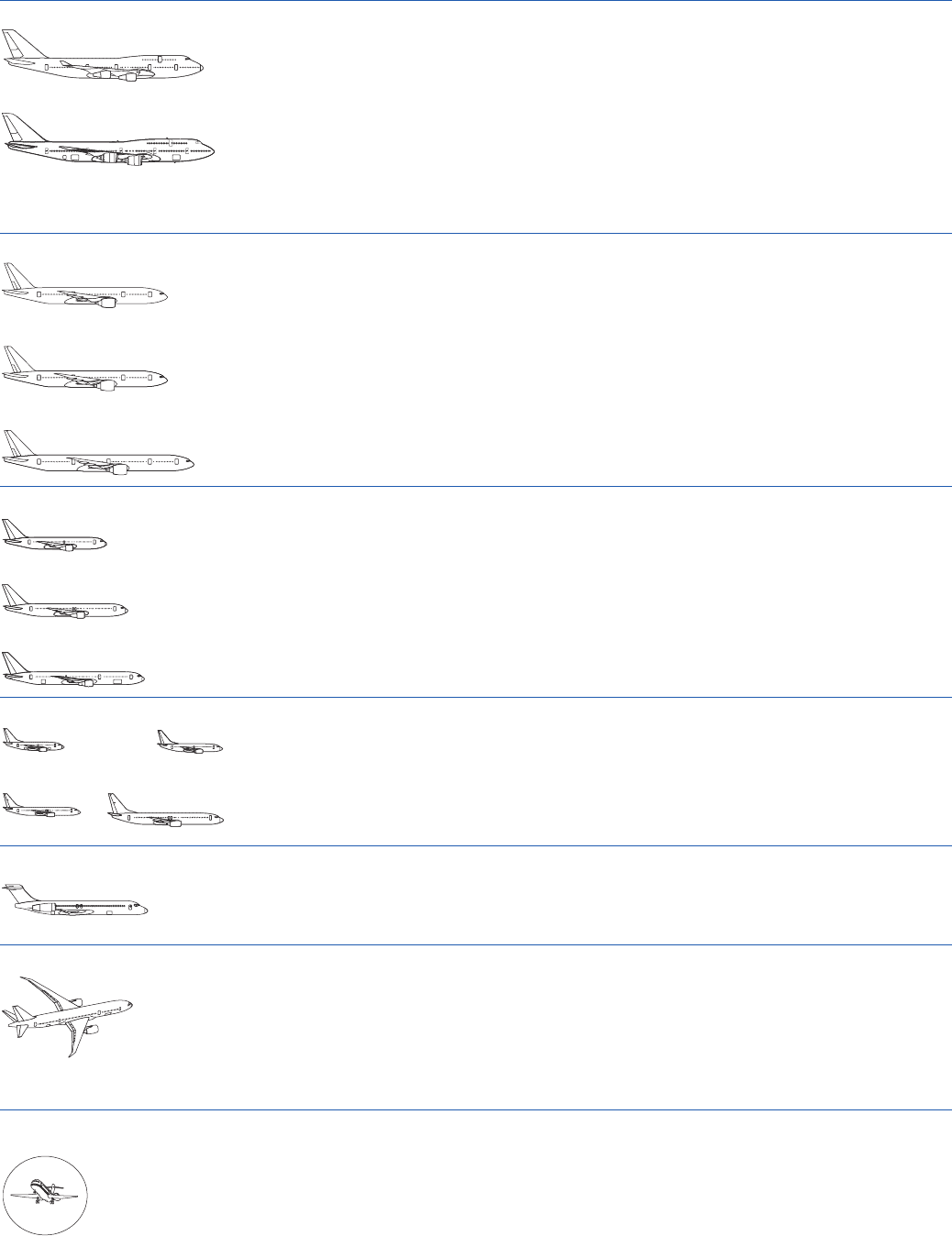
The Boeing Company and Subsidiaries 89
The Boeing 747-400
747-8
In late 2005, Boeing launched the
747-8 program, including the 747-8
Intercontinental passenger airplane and
the 747-8 Freighter. The Freighter will
enter service in 2009, followed by the
passenger version in 2010. The 747-
8 will be the only airplane in the 400-
seat market, seating 450 passengers
in a typical three-class configuration
(34 more than the 747-400). The
Freighter will carry 23 more tons than
the 747-400 Freighter and will be the
industry’s only nose-cargo-loading
jet. Both the passenger and freighter
variants of the 747-8 have an
increased maximum takeoff weight of
435,456 kilograms (960,000 pounds)
and represent a new benchmark in
fuel efficiency and noise reduction,
allowing airlines to lower fuel costs
and fly into more airports at more
times of the day. Production of the
747-400, primarily the freighter ver-
sion, will continue until the 747-8
family enters service in 2009.
Orders: 1,428*
Deliveries: 1,366*
The Boeing 777-200ER
777-200LR
777-300ER
The 777 family of airplanes is pre-
ferred by airlines, passengers and
investors. The 777 seats from 301 up
to 368 passengers in a three-class
configuration with a range of 5,210
nmi (9,649 km) for the 777-200 to
9,420 nmi (17,446 km) for the 777-
200LR Worldliner (Longer Range).
The 777— the world’s largest twin-
jet — is available in six models: the
777-200; 777-200ER (Extended
Range); a larger 777-300; two new
longer-range models, the 777-300ER
and the 777-200LR (the world’s
longest-range commercial airplane);
and the Boeing 777 Freighter.
Orders: 827*
Deliveries: 539*
The Boeing 767-200
767-300
767-400
The 767-200 will typically fly 181 to
224 passengers up to 6,600 nmi in
its extended-range version. The 767-
300, also offered in an extended-
range version, offers 20 percent more
passenger seating than the 767-200
and has a range of 6,100 nmi. A
freighter version of the 767-300 is
available. Boeing also offers the
767-400ER, which seats 245 to 304
passengers and has a range of 5,645
nmi. In a high-density inclusive-tour
arrangement, the 767-400ER can
carry up to 375 passengers.
Orders: 965*
Deliveries: 935*
The Boeing 737-600 737-700
737-800 737-900ER
The Boeing 737 is the best-selling
commercial jetliner of all time. The
newer 737s (-600/-700/-800/-900),
including the recently launched
737-900ER, incorporate advanced
technology and design features that
translate into cost-efficient, high-
reliability operations and superior
passenger satisfaction. The 737 is
the only airplane family to span the
entire 110- to 215-seat market with
maximum ranges up to 3,365 nmi. This
flexibility gives operators the ability to
respond to market needs. The 737
family also includes two Boeing
Business Jets — derivatives of the
737-700 and -800 — as well as a con-
vertible passenger-to-cargo derivative.
Orders: 6,099*
Deliveries: 4,966*
The Boeing 717-200 In January 2005, Boeing announced
that it would complete production of
the 717 jetliner after meeting its cur-
rent commitments to customers. The
durable and ultraquiet 717, serving
the 100-seat market, will continue to
provide its operators with reliability
and efficiency for decades to come.
The last Boeing 717 entered final
assembly in February 2006.
Orders: 155*
Deliveries: 150*
The Boeing 787 Boeing is focusing its new airplane
development efforts on the Boeing
787 Dreamliner, a super-efficient
commercial airplane that applies the
latest technologies in aerospace. The
airplane will carry 200 to 300 pas-
sengers and fly 8,000 to 8,800 nmi,
while providing dramatic savings in
fuel use and operating costs. Its
exceptional performance will come
from improvements in engine tech-
nology, aerodynamics, materials
and systems. It will be the most
advanced and efficient commercial
airplane in its class and will set new
standards for environmental perform-
ance and passenger comfort.
Orders: 291*
First delivery scheduled for 2008
Selected Programs, Products and Services
*Orders and Deliveries as of Dec. 31, 2005
Boeing Commercial Airplanes Alan R. Mulally, President and Chief Executive Officer, Renton, Washington, U.S.A.
Boeing Commercial
Aviation Services
Boeing Commercial Aviation Services
provides the most complete portfolio
of commercial aviation support
products and services in the industry.
This organization is an important
component in the company’s total
solutions approach. It offers a wide
range of products and services
aimed at bringing even more value
to our customers. This includes a
comprehensive worldwide customer
support network, freighter conver-
sions, spare parts, airplane modifica-
tion and engineering support.
Commercial Aviation Services also
oversees a number of joint ventures
such as Aviation Partners Boeing
and wholly owned subsidiaries,
Jeppesen Sanderson, Inc., and
Continental DataGraphics.


